Kitchen gardens: 10 steps to grow vegetables in your backyard
Start a kitchen garden in your backyard for fresh vegetables, fruit and herbs ready for eating – whether your plot is small or spacious.
Camille Dubuis-Welch
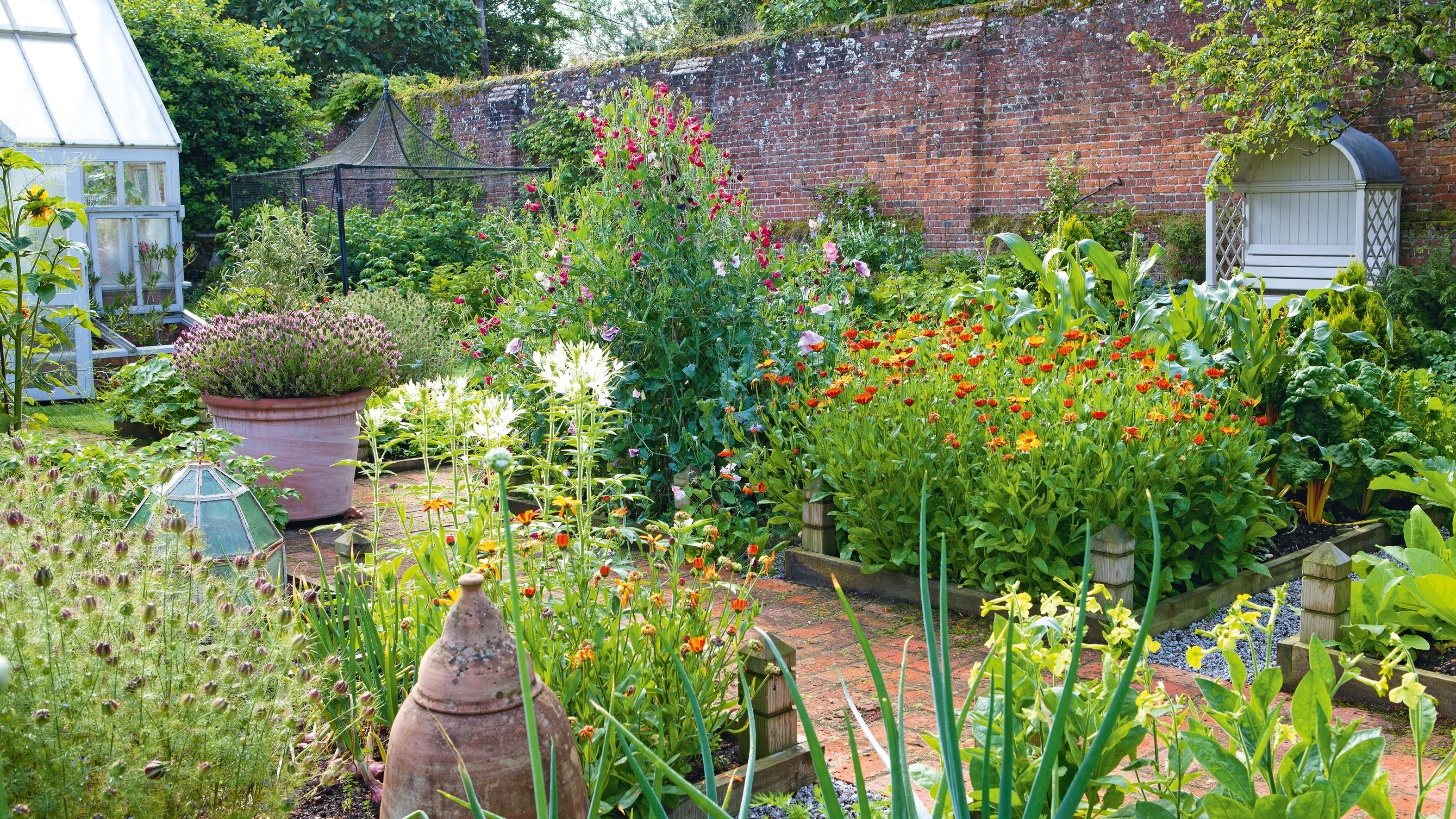
A thriving kitchen garden is something to be proud of. A place to grow your own – whether you're vegetable gardening in raised beds, pots, from seed, or not, there is nothing better than using the freshest ingredients for the kitchen table, straight from your own backyard.
Homegrown produce is not only tastier and healthier but, when your vegetable plot is well and truly thriving, it could even cut down on your grocery bills. In fact, growing your own fruit, veg and herbs in your garden is becoming so popular these days that sales of vegetable seeds are overtaking those of flowers...
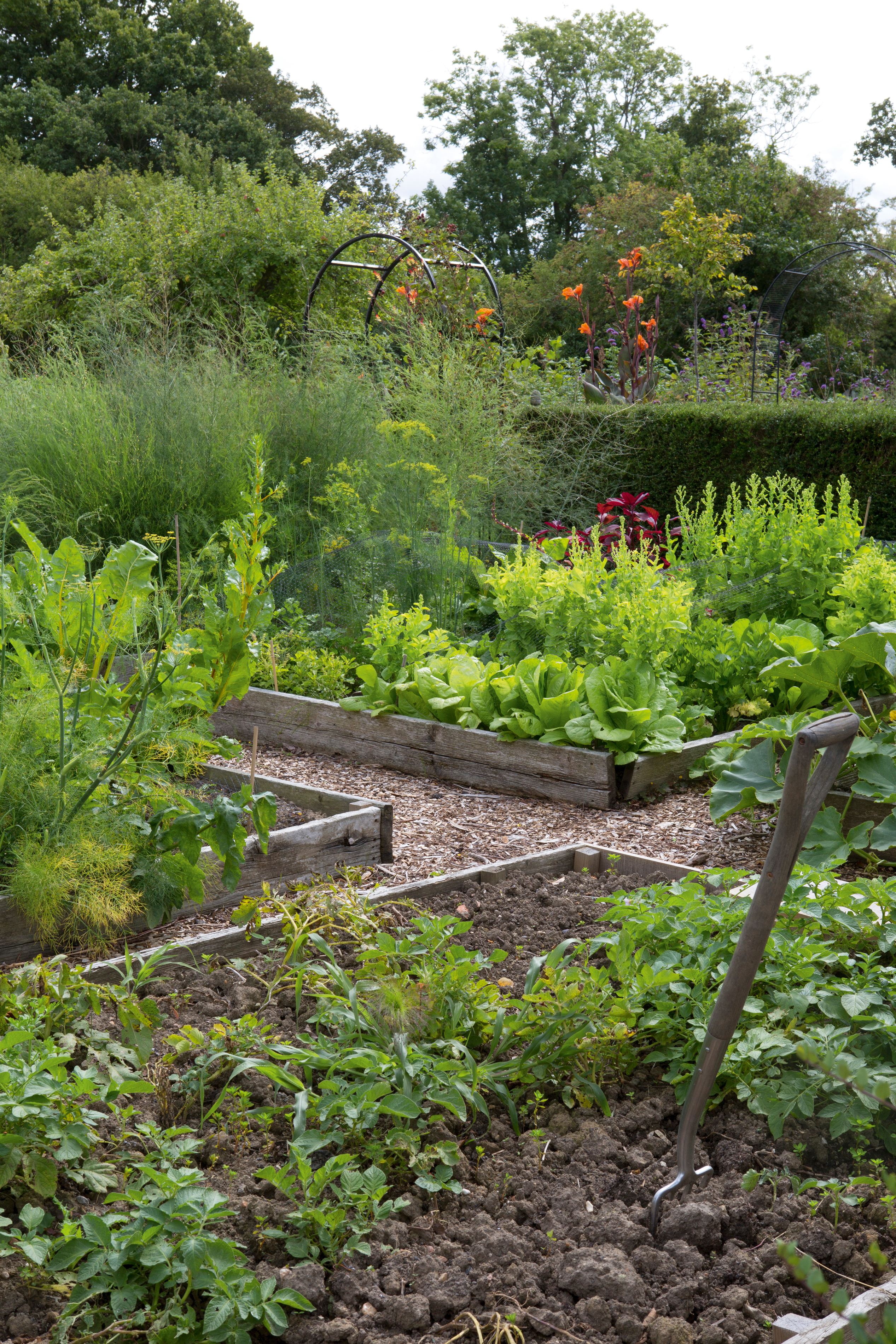
Vegetables have been planted in neat raised beds in this kitchen garden
There are a few different ways of vegetable gardening in your backyard but the approach remains the same as when planning for the best garden plants. You need to understand your plot and climate to know exactly what you can grow successfully.
If you have a small yard, you can consider pots, or incorporating veg into garden borders. If you don't have a lawn to build beds into, even a patio can make the ideal growing spot. You can also grow vegetables in a small backyard, like our content editor Eve Smallman has.
Why is it called a kitchen garden?
Bryan McKenzie, landscape designer, gardening expert and Co-Founder of the bumpercroptimes.com blog comments, 'A kitchen garden is one that includes vegetables, fruit, herbs, and leafy greens that can be harvested for instant use for cooking. You can also make your kitchen garden more visually appealing and practical by growing some edible flowers. A kitchen garden is usually quite compact to provide the household with a moderate supply of fresh produce without waste.'
How to start a kitchen garden in your yard
Cinead McTernan, author of City Veg: Inspiration from an Urban Garden available on Amazon says: 'The main thing to think about when planning your plot is what it is you actually have to work with. It helps if you’ve been able to study it over the year, so that you know where the first of the sun’s rays fall, where the frost lingers and which plants might be affected by strong winds. It’s really interesting to see how your plot changes with each season, and keeping note of all its quirks and characteristics will help you sow and plant with the confidence that you’ve given your crop the very best chance to thrive. If you are discovering your plot for the first time, general rules of thumb will apply – and in fact are more applicable to a small space, as there is less possibility of fluctuating temperatures and idiosyncratic light levels – so finding out which direction your garden or balcony faces is a good start.'
1. Start your kitchen garden at the right time

Enjoy freshly picked, homegrown delights, from your kitchen garden plot
Early spring is an ideal time to start vegetable gardening, but you can of course, start planning well ahead. Decide on the size of the plot you would like. Make sure you keep to a size you can manage. A large vegetable garden with room to grow everything will take a lot of work, both preparation and maintenance. A smaller plot with dwarf varieties, or produce mixed in among flower beds, or planting in containers would work better if you don't have much time for gardening.
Get small space home decor ideas, celeb inspiration, DIY tips and more, straight to your inbox!
2. Choose the best position for your kitchen garden

It's perfectly possible to grow a good selection of fruit and vegetables in pots. Strawberries make a particularly attractive display, in flower and in fruit
The amount of space and light levels of your chosen growing spot will be the determining factor in what you grow, and you need to understand how much room you can offer each plant to grow in a raised bed or pot, before you get started. 'Measure the site to know square footage,' advises McKenzie, and 'Plan the layout of the garden to ensure that all the plants are accessible and will receive enough sunlight.'
You need to treat plants a little like royalty, as if they feel cramped, then you can’t guarantee that they will produce as well as they may have done! To understand how much space each vegetable or fruit plant will need, check the seed packet and then select your pots and containers accordingly because this will make your life a heck of a lot easier.
To achieve the best results when growing fruit and vegetables you need:
- An open, sunny spot: Preferably one that gets the morning sun, and around six to eight hours of direct sunlight daily. To grow quickly and well, vegetables need as much light as possible, so track the sun throughout the day to see where shadows fall. If you don’t have these conditions, there are some crops that tolerate shade, such as cherries, blackberries, raspberries, rhubarb and blackcurrants. 'Figure out what parts of the area receive the most sunlight to locate the most sun-loving plants there or to cascade the plants from lowest to highest to prevent the second from shading the first' says McKenzie.
- Wind protection: A permeable barrier, such as a picket fence, hedge or windbreak can filter its effect.
- Fertile soil: Soil enriched with compost. Learning more on growing organic is a wise move here.
3. Test and prepare the soil for your kitchen garden

McTernan says 'Establishing what type of soil you have will dictate your plans, too – not only which plants you can grow, but also what they can be grown in. If, for example, the soil is heavy clay, you might want to grow veg in raised beds filled with more accommodating topsoil. While soil structure can be improved and even changed over time, coping with heavy clay or poor, sandy soil is an uphill battle and an alternative approach to growing might be a sensible, and ultimately time-saving option.'
So to get the best homegrown crops from your kitchen garden you need to make sure your soil is up to scratch. It's useful to test the pH levels of the soil in your vegetable garden to help you select crops to suit it. McKenzie adds, 'Aerate the soil before fertilizing to ensure that the soil is enriched with oxygen, drains well, and allows the fertilizer to saturate it as deeply as possible.' He also advises to 'Make a lab or DIY soil test to balance out nutrients and pH before planting.' pH soil monitors are easily found on Amazon.
Weeding and working the soil
First thing to do is to clear all the weeds or plants or turf (the latter can be stashed somewhere with the grass face down; after a while it will become a great top soil that you can put back on the bed for next season).
Dig over the soil, then cover the vegetable patch with clear plastic sheeting for a couple of weeks to dry out and warm up the soil (if you're starting off in spring, which is ideal). This will also help any dormant weeds emerge so that you can whip them out before you start planting.
Improving your soil
The next thing to do is improve the soil – and it never hurts to. You can do this by digging in organic matter, such as well-rotted manure or compost. Your local garden center might also have composted bark, mushroom compost or leaf mold. Ask them – assuming the staff is knowledgeable – what best suits the local soil. And if they know, ask them if you need to do anything else.
Soils are generally on a spectrum from clay to sand and can vary from place to place within your garden. All soils will benefit from the addition of organic matter to retain moisture and nutrients.
Clay soil needs breaking up and takes longer to warm up so suits later crops. Light soils are good for early vegetables but need large quantities of manure and compost to avoid water draining away too rapidly. The ideal soil is loose, crumbly loam, which absorbs and holds water and nutrients, is well aerated and drains freely.
McTernan adds: 'The same can be said for water levels in your plot – a soggy patch is hard to regulate (unless it’s caused by a leak) so unless you fancy growing watercress or rice, it might be worth building raised beds here too.'
4. Decide on the fruit and vegetables to grow
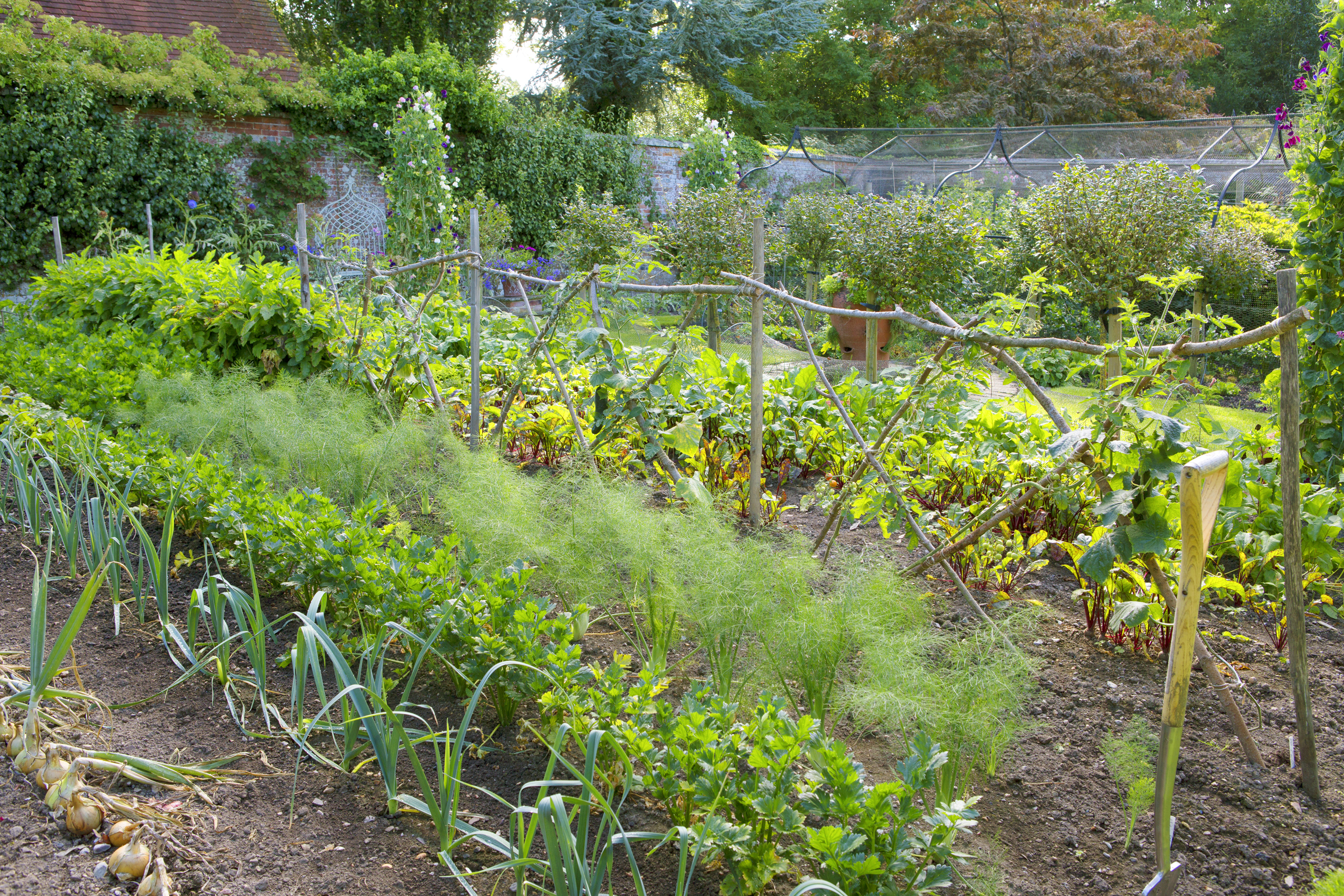
Try using branches and twigs for homemade climbing supports, as used here among these rows of onions, carrots, beetroot and fennel
'Once you’ve established these fundamentals, it’s then a case of deciding what you’d like to grow. Are you experimental and interested in trying more unusual crops that are hard to buy in supermarkets and shops? Or perhaps you hanker after the taste of home-grown tomatoes – a flavour that is hard to find from intensely farmed crops, which are either firm and tasteless or soft and overly sweet. Does a weekly harvest appeal to you or are you looking to pep up home-cooked dishes with fresh herbs and spices? I think it’s worth saying again here that the idea of being sustainable in terms of fruit and vegetables is a stretch, and it all depends on the size of your family as well as the quantity of fresh produce you consume. My aim is to grow a variety of seasonal veg that provides a weekly (not daily) harvest throughout the year, to take centre stage each week, and allow us to enjoy a sense of seasonality, as well as the fun of finding something to eat in our own back yard. Deciding why you’re growing will help you formulate a design, too.' Says McTernan.
Grow what you love to eat, and as much as you need. Make a list of your favorite edibles, including herbs, and consider those that are more expensive to buy. Include different varieties of vegetables you enjoy, then look carefully at your space and growing conditions and narrow your selection.
If you’re a beginner gardener, try and keep things simple, especially. The concept of growing your own produce is beyond exciting and believe us, the want to start ALL the seeds and to plant all the veg going in your local garden center will be strong, but you must resist.
Work with what you have, start small and over time, you’ll be able to know what you and your space can take on for success, every time. We've listed the best vegetable garden plants for amateurs further down.
Also think about which plants are set to succeed in your conditions. Ideally you want to use non-toxic pest control and one way to achieve this is picking hardy plants that have the best chances of survival. Going for things that match your soil type and conditions gives them a head start against pests.
You want to aim for a succession of crops throughout the seasons, with small plantings every couple of weeks for a year-long harvest. It is worth tracking down organically grown seeds and plants. Conventionally grown plants are already often loaded with pesticides and chemical fertilizers. See our guide to the best online garden centres.
5. Work out how to get the best value from your kitchen garden
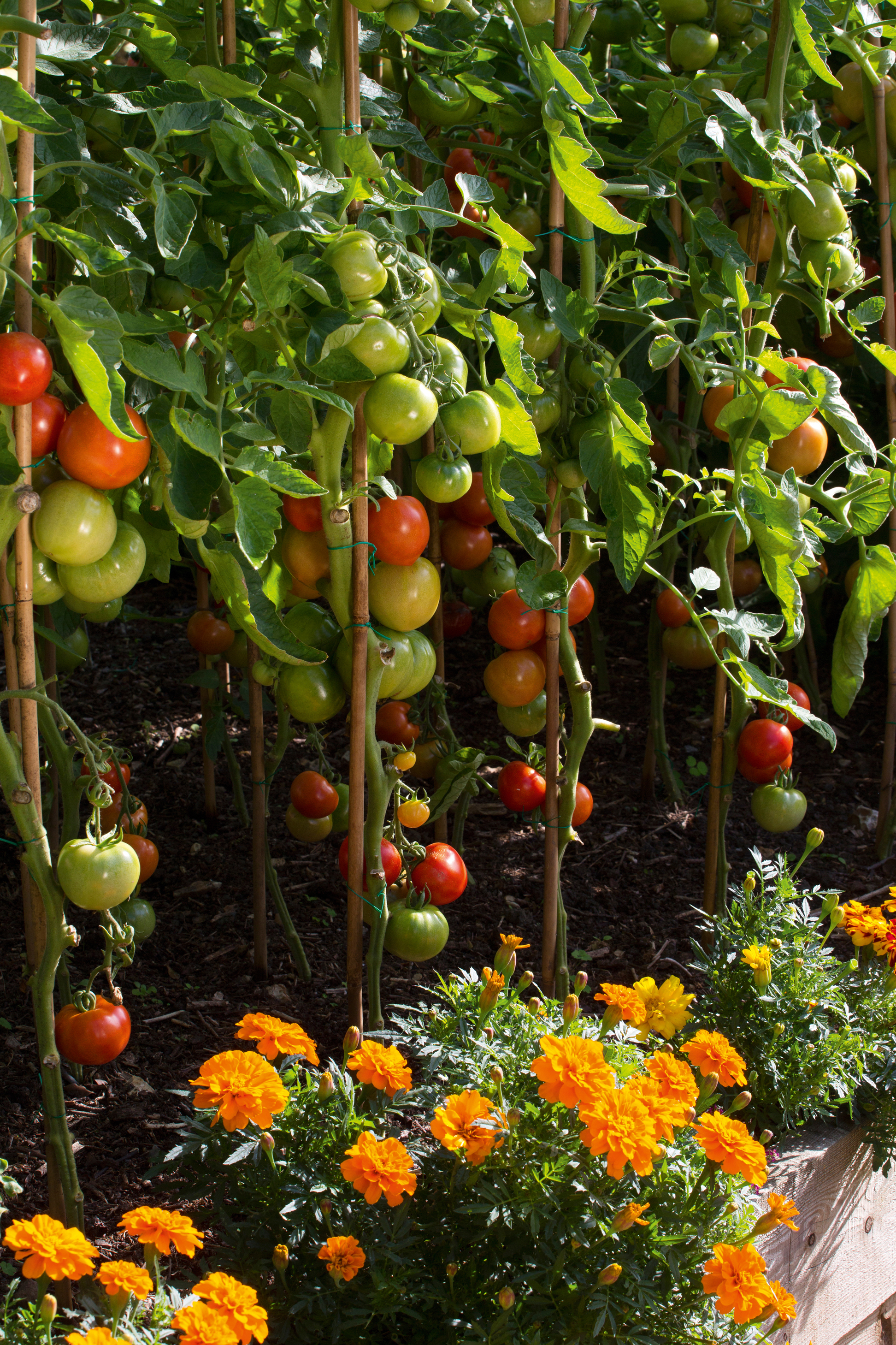
- Grow high-value crops that take up little space. Tomatoes are high maintenance and need lots of watering and feeding, but they grow vertically and produce lots of fruit. You can also grow different varieties to those available in stores – from tiny yellow cherry tomatoes to large black varieties to minimize your time, space and money while getting the maximum results.
- Aim for increased yields, plus improved taste and value compared with shop-bought produce.
- Swap seeds with family and friends.
- Homegrown salad leaves are a cheaper alternative to bagged ones from the supermarket – and less wasteful. Sow cut-and-come-again varieties every few weeks for a succession of cropping.
- Choose crops that are expensive to buy compared with growing them yourself – for example herb garden picks, such as mint, sage, thyme, parsley and rosemary. These are easy to grow and you’ll be able to harvest them fresh for up to nine months of the year. Many herbs are perennial and will keep coming back year after year. Swiss chard is easy to grow, prolific almost all year, and isn’t readily available in most supermarkets.
- Grow crops that taste better fully ripened and fresh from the plot, such as strawberries.
- Fruit trees will yield well once established and if short on space try cordons or espaliers against a sunny fence. Choose varieties that aren’t usually found in supermarkets.
6. Grow a kitchen garden in raised beds

With deep raised beds you can ensure the plants have the most nutritious soil in which to grow
Raised beds, filled with a loamy soil from a local garden center, are ideal for growing small plots of vegetables are a good option if the soil in your garden soil isn't great quality. They provide good drainage, increase soil temperature, prevent soil compaction and they are really accessible.
The sides of the bed prevent soil from washing away in heavy rain and act as a barrier to pests, such as snails and slugs, as well as pathway weeds.
You can buy ready-made raised beds for your vegetable garden, or you can make raised beds yourself.
Wooden planks or old railway sleepers look good and are often used to create vegetable beds. Brick or stone surrounds are long-lasting, while woven willow looks rustic but will need to be replaced about every six years. Timber beds should be lined with black polythene to keep the timber dry and extend its life.
7. Decide how to layout your kitchen garden
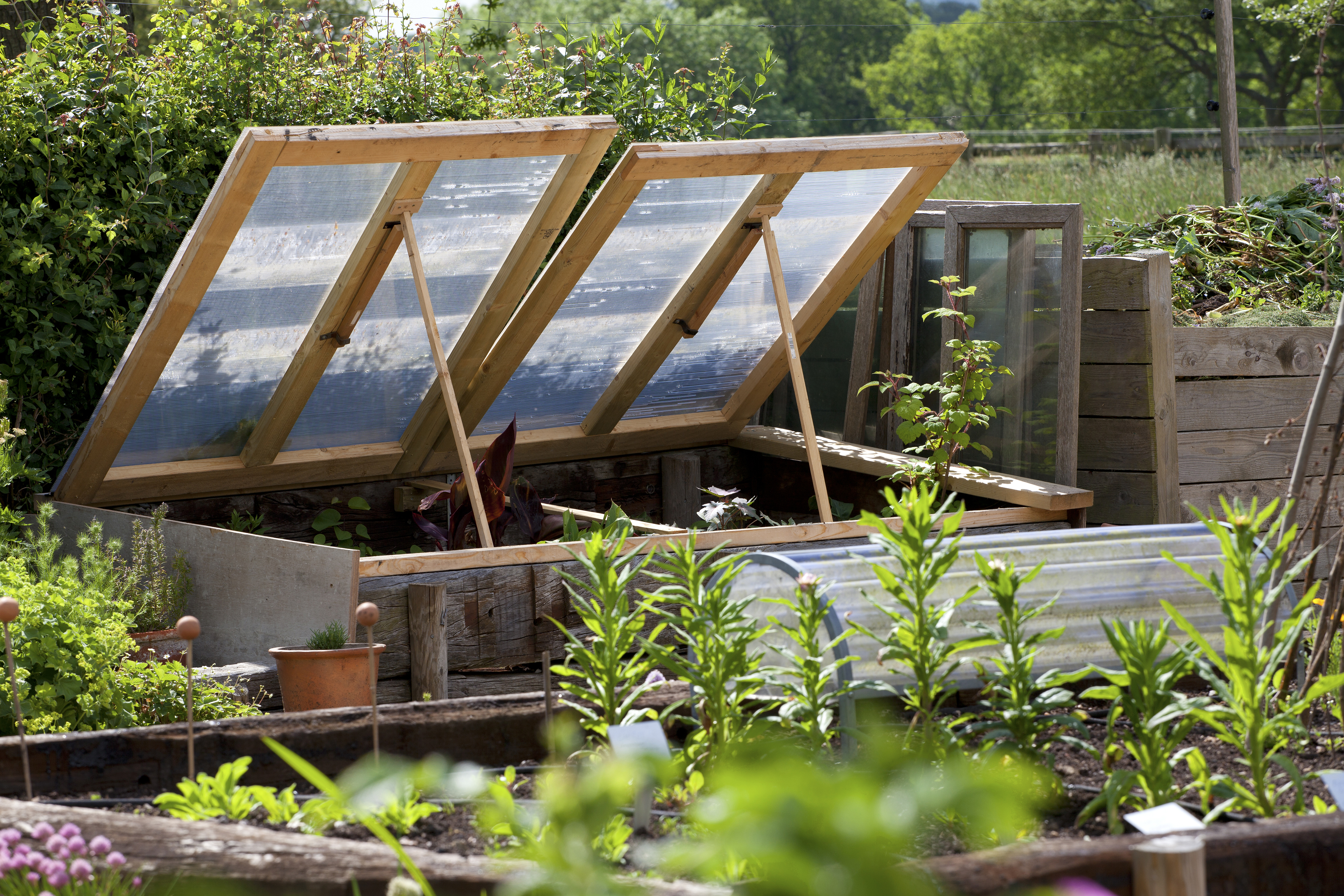
Every plot is different, so work out the best design for your space and needs. There are no rules to creating a kitchen garden however, the easiest way we've found to plan a vegetable garden is to divide the land you've allocated to vegetables into four sections: one for root vegetables; one for salads and herbs; one for beans and peas (or legumes as they're sometimes called); and one for a mixture, for example tomatoes, cucumbers, and the like. The reason you need to do this is as you are not meant to use the same soil for the same crop two years in a row. So, dividing your plot will allow you to rotate your crops.
How big should it be? An area of around 2m x 3m is easily enough for vegetable gardening for beginners. Our advice: start small and if you're successful, you can expand. McKenzie advises to simply 'Mark the plant beds at the right distance from each other, dig seed holes, sow, and water!'
McTernan notes 'While these practical considerations form the foundations of your design, there is plenty of opportunity for you to be creative – though again, using design to solve practical issues involving space is a good starting point (think pleached or lollipop-shaped trees to allow for growing space beneath them) rather than designing around something that is really just a gimmick (think planting in wellies and vintage cans of Heinz tomato soup). Your list contains the building blocks of your design because you’ll know the best spot for each crop you’re hoping to grow (they’ll either be sun-loving or shade-loving plants).'
You can mix vegetables, fruit, herbs and flowers, including edible varieties, in a tapestry of colors and shapes. You can grow them in segregated rows or blocks, or as an ornamental potager, in a geometric pattern of your choice.
Unless crops need special protection, it can be helpful to mix the plantings, as a large area of a single crop attracts pests, and the mix of different edibles and ornamentals confuses them. It is helpful to draw the design of your vegetable garden on paper first before marking out or planting.
8. Create access to your vegetable garden
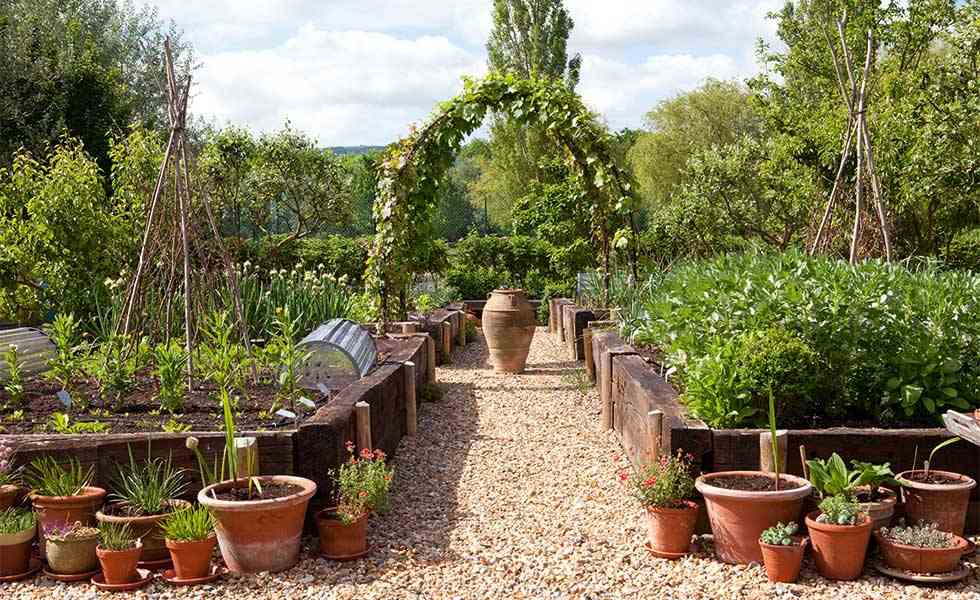
You can sit on the edge of raised beds while weeding and planting. Teepees look good in the centre of the beds and a grapevine clad arch adds a focal point
Include access garden paths, and keep in mind that beds need to be a size you can reach into easily for weeding, planting and harvesting. Don't have long grass or dense flower borders directly next to the plot as these can harbor slugs. A path makes it easier to spot and dispatch the pests.
Make the best use of the vertical gardening ideas, too. Grow climbers, such as peas, beans and cucumbers up tripods and frames, along with nasturtiums to attract blackfly away from crops, and sweet peas for added color and scent. Include companion plants that attract beneficial insects, such as marigolds and daisies.
Fruit trees are a wonderful addition. Espaliers, cordons or step-over trees can be very effective In small spaces.
9. Grow a kitchen garden from seed

Seeds are the lowest cost but if you don’t have a greenhouse or propagator and want a more instant result, plug plants are a good option.
A combination of plants and seeds may work best; you can have seed trays inside on a windowsill, then pot on seedlings into the garden. Many vegetable seeds can be sown directly in situ once the soil warms up.
Plan a program of small, successive sowings and plantings every couple of weeks for a yearlong harvest. Edge plots with contrasting plants, including herbs and flowers, which will mask bare spots as the season progresses.
The rule for sowing all seeds outdoors is that you must wait until all risk of frost has passed, and the soil is at least 7°C – seeds will not germinate below that temperature. You can warm up the soil a few weeks in advance by covering it with plastic sheeting or even plastic bottles cut in half, but it may be less labor-intensive to start your vegetables indoors. You will need seedling trays and seed compost. Keep on a bright window sill, but avoid overly hot places by radiators. Plant out when all frosts have passed and your seedlings are nice and strong, but before they get too tall and droop. As a general rule, don't sow your seeds indoors earlier than six weeks before you plan to plant them out.

Fencing can help to protect crops, and tripods smothered with beans and sweet peas makes the best use of vertical space
After harvesting, use fast fillers, such as chervil or cut-and-come-again salad greens. These self-sow and can be moved easily to fill gaps when required. Fast-growing green manures are ideal: both mustard and phacelia are tough as well as beautiful in flower.
In February, you can start sowing choices such as broad beans, peas, carrots, onions, the first potatoes and salad crops under cloches. You can’t beat Swiss chard and perpetual spinach that will crop for a whole year and throughout winter. Salads can also be grown year round, and many of the most expensive to buy at the shops, such as rocket and baby leaves, are the easiest to grow.
Other easy to grow edibles include tomatoes, potatoes, beets, zucchini/courgettes, garlic, onions, squash, strawberries, chives and mint. Vegetables, fruit and herbs can look beautiful, so be proud of your bounty.
10. Fuel your vegetable garden with scraps
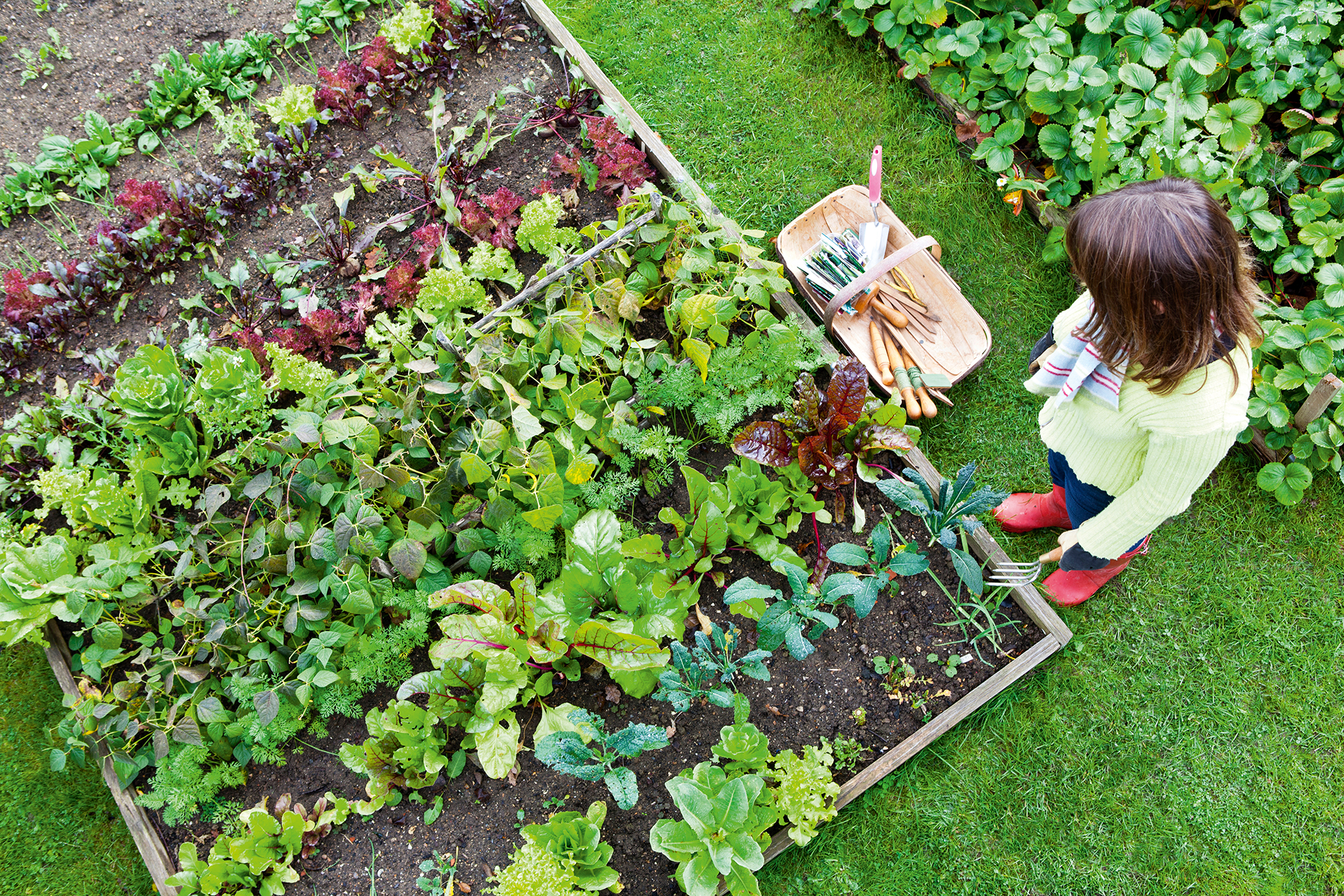
If you're looking for ways to get the kids involved with vegetable gardening and to reduce food waste too then you'll love this idea. It's possible for a lot of popular veggies, including celery, cabbage, bok choi, beets, turnip, romaine lettuce, leek, spring onions, lemongrass, avocado pit, garlic sprouts, carrot top (green), parsnip top (green) to be grown from their leftover scraps using a regrow kit like the Brabantia Tasty+ Herbs and Vegetables Regrow Kit – or your own DIY version.
All you need to do is pop your scraps in the base of the regrow kit, which should be submerged in water. Place the kit in a sunny spot and keep an eye on the water levels every few days. After a few weeks, you should notice some growth, at which stage you can transfer your veggies to a plant pot.
How do I start a small kitchen garden?
McKenzie also shares some advice on vegetable gardening in a smaller more urban space: 'Well, my best tip to start a vegetable garden in your yard is to… start!' To not be put off by the size of your plot, 'Start by planning your thriving future garden.
'Especially in small/urban outdoor spaces, you will enjoy the idea of putting compact wooden/stone/plastic trays with soil and growing your veggies in them. This option works for small paved backyards, rooftops, lawns that you want to keep neat, etc. This approach will also optimize soil and water use.' You can take this approach when balcony gardening also.
If you do have a small space and are more inclined to start container gardening, horticulturalist and garden expert, Matt James, recommends to 'Try salad leaves such as ‘Saladini’ and baby leaf spinach in shallow trays. For baskets and window boxes, choose trailing tomatoes, such as ‘Tumbler’ and ‘Garden Pearl’. Perpetual strawberries also grow well in deep boxes, but regular watering is essential – ‘Mara des Bois’ and ‘Aromel’ varieties are suitable. Zucchini/courgettes and dwarf runner beans (namely ‘Hestia Dwarf’) crop well in large tubs. In very hot sunny spots, sweet peppers and eggplant/aubergine are good, as are herbs such as basil and sage. Early potatoes (try ‘Swift’ or ‘Charlotte’) are a doddle to grow with peat-free compost in an old compost bag or plastic dustbin.'
Caring for your vegetable garden
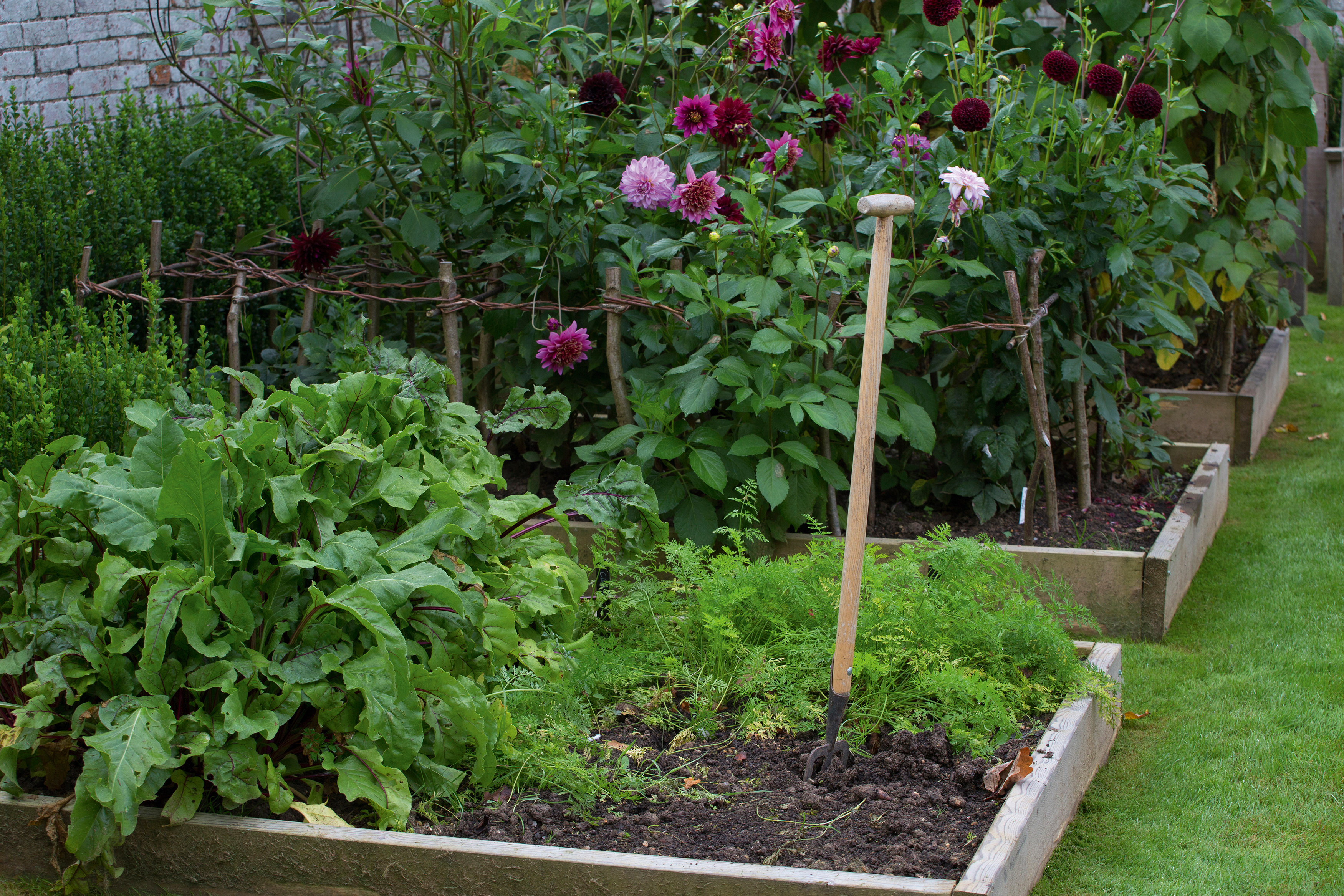
Watering a vegetable garden
Vegetable crops are thirsty: you will need to water them thoroughly, aiming to moisten at least 30 centimetres of the soil. This means a good, long soak about once a week, rather than quick and shallow daily watering. Almost all vegetable crops have this requirement, including tomatoes, salad leaves and lettuce, and root vegetables. If your soil has poor water retention (loam soil for example), mix in some sand to improve it. Mulching vegetable beds with leaves, manure, or compost will also improve water retention, but avoid the mulch touching the actual plants. If you are growing vegetables in containers, they will need more frequent watering, as the water evaporates very quickly from pots.
Weeding a vegetable garden
A decent layer of mulch will prevent weeds from spreading, so once you've planted up your seedlings, add a couple of inches of it over the soil in between the rows. This will give your veggies the best possible chance to grow unhindered, and will cut down on the amount of weeding work (boring) that you have to do.
Monthly checklist
Here is a calendar of jobs by month to ensure you get the best crop and enjoyment out of your kitchen garden. Follow our advice to reduce pests and protect your veg.
April
- Use organic controls as the first pests appear
- Continue sowing seeds as the soil is warmer
- Plant herbs in ground or pots
- Keep on top of weeds
- Sow tender vegetables under cover, such as zucchini/courgettes, marrows and beans
May
- Plant leeks, brassicas, celery
- Continue succession sowings of salads and herbs
- Sow French beans
- Harden off plants started off in the greenhouse
June
- Plant out tender veg seedlings
- Put straw around strawberries and net from birds
- Hoe weeds
- Remove side shoots of tomatoes and feed weekly
- Mulch and feed asparagus
- Thin out apples, pears, plums
July
- Cut back foliage and remove runners from strawberries once they've finished cropping
- Net soft fruit
- Cut down early peas and broad beans after harvesting
- Lift and harvest new potatoes
- Continue sowing salads
- Prune blackcurrants after they have been harvested
- Mulch squash and water well
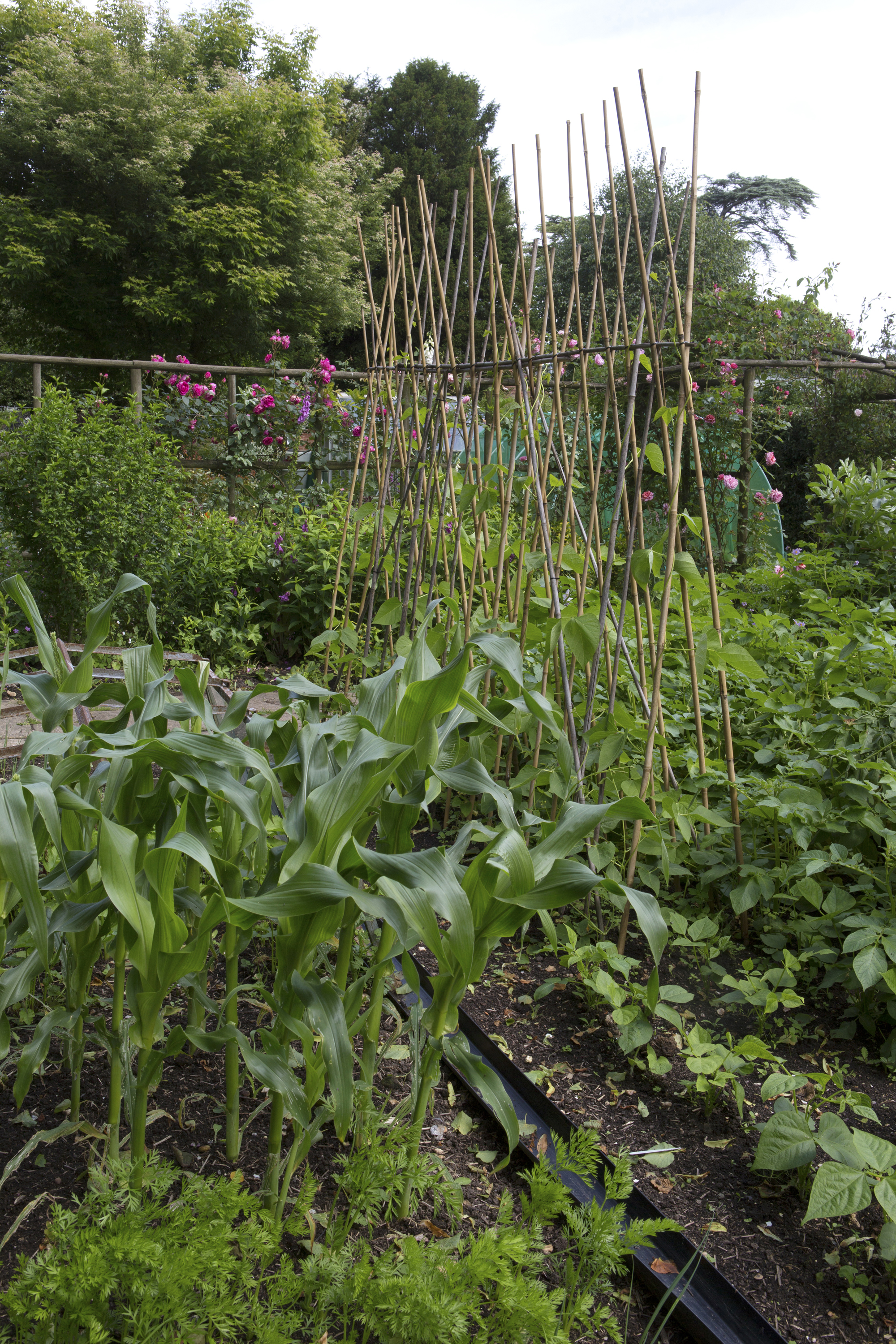
August
- Sow Oriental pak choi and Chinese cabbage
- Remove finished crops and replace with quick- growing salads
- Sow overwintering onions
- Prune summer fruit
September
- Continue sowing Oriental veg, herbs and salad
- Sow winter lamb’s lettuce, cress and endive
- Pinch out top of tomato plants
- Harvest squash and sweetcorn
- Begin harvesting apples and pears
- Dig up potatoes when they finish flowering
- Stake or earth up sprouts and brassicas to help them stand during winter
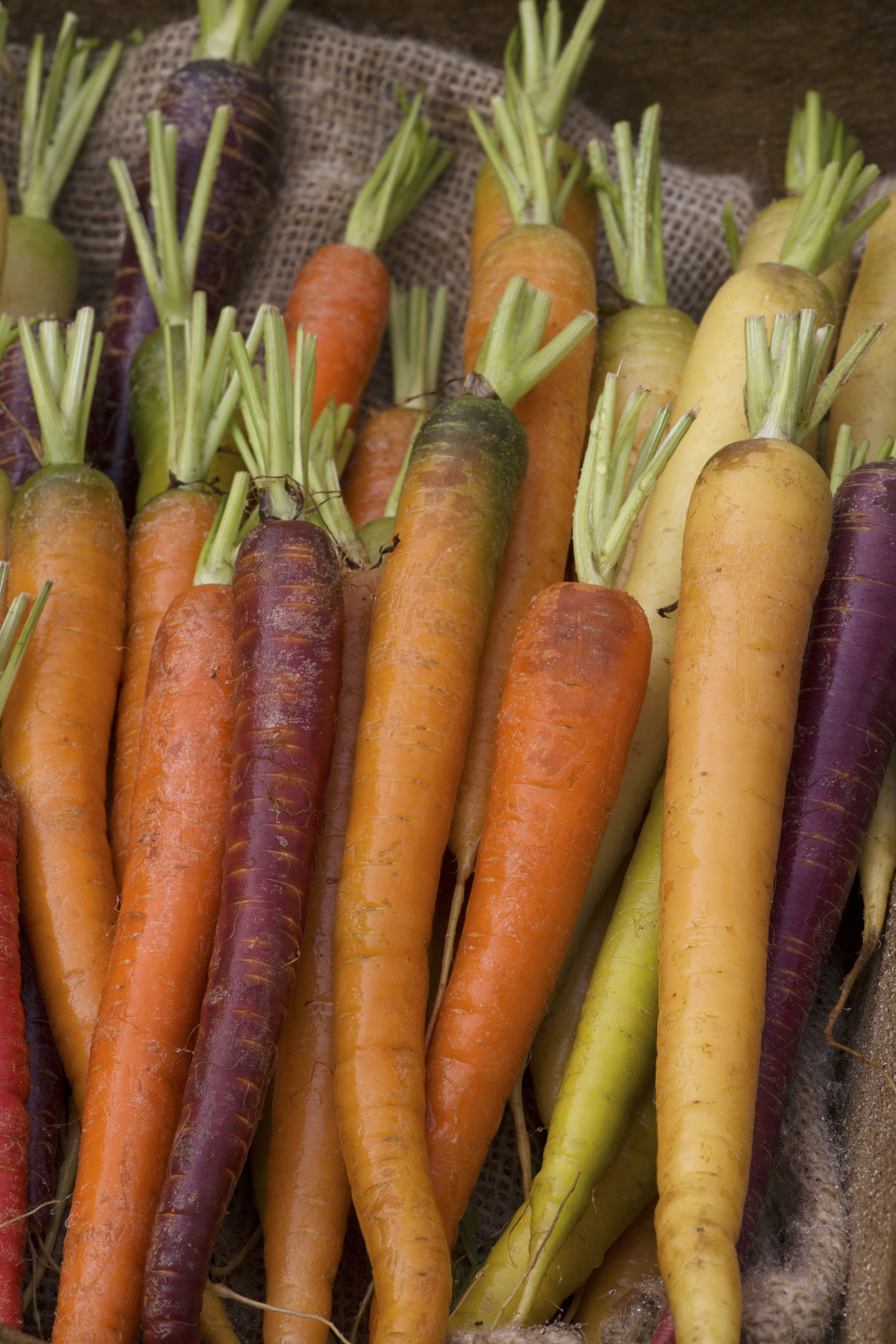
Try growing different varieties of heritage carrots
- Need more tips on gardening for beginners? We can help.
October
- Harvest squash before frost
- Lift and store potatoes
- Dig over soil
- Plant garlic and broad beans
- Cut back artichokes and remove sweetcorn plants
November
- Clear the soil
- Harvest leeks, artichokes, celery, parsnips and the last carrots and beetroot
- Net brassicas
December
- Dig over bare soil incorporating compost
- Prune grapes and fruit trees
January
- Order seeds and get supplies while sales are on
- Clean pots ready for sowing
- Harvest final sprouts, cabbages and leeks
- Start to chit potatoes
February
- Complete your digging
- Inside, sow seeds such as onions, tomatoes, peppers and celery
- Cover rhubarb plants with forcing pots
- Plant fruit trees when the soil is not frozen
- Cover soil to warm for sowing
March
- The main month for sowing many crops, including brassicas, leeks, parsnips, peas, spinach
- Plant asparagus
- Plant out the first potatoes, onion sets, garlic, shallots and artichokes
- Fertilize fruit and vegetables
Kitchen gardens to visit in the UK
West Green House Gardens – Imaginative, ever-changing creative potager displays. Near Hartley Wintney, Hook, Hampshire RG27 8JB
West Dean Gardens – Restored walled Victorian kitchen garden and glasshouses, with heritage and new vegetable varieties. West Dean, West Sussex PO18 0QZ
Pashley Manor Gardens – Decorative home kitchen garden. Ticehurst, East Sussex TN5 7HE pashleymanorgardens.com
Attingham Park – Late-18th-century kitchen garden, two acres of glasshouses and Georgian bee house. Atcham, Shropshire SY4 4TP
Audley End House & Gardens – Organic walled kitchen garden, with over 120 apple and 60 tomato varieties. Saffron Walden, Essex CB11 4JF
20 easy vegetable garden plants for beginners

- Salad leaves – and lettuces are easy to grow from seed in the ground or containers, and give a high yield. Cut-and-come-again salads give a succession of leaves, from five to eight weeks after sowing – an economic alternative to expensive salad bags in shops and much fresher and tastier. They like fertile, moisture-retentive soil. Sow more every four to six weeks for a continuous supply.
- Tomatoes – are easy to raise from seed from March on a warm windowsill with plenty of light, or buy plants from your garden centre in May. They need nutrient-dense soil. Sun-ripened tomatoes from your garden will beat the taste of any you can buy. ‘Bush’ tomatoes are the easiest as they don’t need to be staked or trained and grow happily outside in pots, hanging baskets or grow bags.
- Broad beans – are good yielders and use the vertical space rather than taking up ground level space. Easy to grow from seed, water them well and harvest regularly – the more you pick, the more the plant will produce. Broad beans can be sown direct into the ground in March or April. Sow French, borlotti and runner beans at the end of May/early June, for a harvest 12-14 weeks later.
- Runner beans –The humble runner bean does very well in patio containers, provided you water the plants often. Like other edible plants, runner beans prefer a sunny, sheltered spot; they will give you a continuous harvest from July onwards, if you pick them regularly. Plant container runner beans between February to April, where they are to grow. Only put the container outside in your kitchen garden when it's really warm, ideally from late May onwards. An added bonus with scarlet runner beans is that the vibrant flowers are also edible.
- Carrots – Sow early carrots under cloches in February, or wait until March or April in the open. For sweet, small carrots, sow every few weeks from early spring to late summer for a successional harvest from June to November. They like light soil, with plenty of organic matter dug in with full sun for early varieties, or some shade for main crop varieties. Carrots can also be grown in containers and raised beds; thin out the seedlings in the evenings, firming down the soil to help prevent carrot fly. Water when the weather is dry.
- Potatoes – Plant chitted seed potatoes in the ground or containers – early varieties in late March and main crops in April, ready to harvest in 10 to 13 weeks. They grow best in fertile, slightly acidic loose soil, and need regular watering.
- Beetroot – is easy to grow from seed, in the ground or a pot. Sow directly into the soil in April to July, in medium to light, neutral to slightly alkaline soil that has not been recently manured. Keep well watered and weeded. Round varieties will be ready to harvest from 11 weeks. Golf ball size are tender and delicious and the leaves can be used as an alternative to spinach or in salads.
- Chard/silverbeet – Easy to grow, sow chard in spring, keep well watered and add liquid feed regularly. It often grows over a number of years as a perennial. Rainbow varieties add the wow factor whether in neat rows on the plot or mixed among garden flowers. Try ‘Bright Lights’, ‘Rainbow’ or ‘Ruby’. A great addition to stir-fries.
- Apples – Bare-root fruit trees can be planted from November to March. Self-fertile trees will produce fruit without the need of another tree to pollinate it. Soak roots, then plant in a sheltered, sunny position, ideally in well-drained sandy loam soil. In a small space, train them against a wall or fence as an espalier. You can also buy espaliered trees in pots at garden centres throughout the year. Water well for the first few years and expect to harvest in a couple of years, depending on the variety. Even small gardens can have apples as step-overs, espaliered, on arches, or columns in containers.
- Gooseberries – Easy to grow, there are many gooseberry varieties. Autumn is an ideal time to plant bare-rooted bushes in a sunny sheltered spot. Prepare the soil by forking over and adding compost or rotted manure and fertiliser to the planting hole. Mulch and water well until they are established. Thin out in late May/early June,and use these first fruits for cooking. The second harvest, a few weeks later, will be sweeter. Net bushes or grow in a fruit cage.
- Currants – Bare-rooted white, red and black currants are available for planting between October and March. Easy to look after, once established they will remain productive for about 15 years. Plant in well-drained soil, with added well-rotted manure. A sunny, slightly sheltered spot is best, but they will grow in part shade. They will fruit from the second summer, but need training, pruning and feeding for best crops.
- Strawberries – For a tasty and decorative treat, grow some strawberries in a hanging basket. Plant in April for a summer harvest. Place five or six plants in a basket, and water daily during the growing seasons. Feed from flowering to harvest time with a product high in potassium.
- Calendula – These quick-growing hardy annuals work well en masse or to edge productive beds as a companion plant to attract beneficial insects. Easy to grow in most soils they will do their best in rich, loose soil in full sun. If grown organically, add the tangy flower petals to salads.
- Herbs – Herbs are the easiest edible plants to grow and deserve a spot in any container garden. You can grow thyme, basil, chives, mint, sage, parsley, cilantro, oregano and rosemary outdoors. Choose herbs that you love to cook with and then keep them near the back door so you can maximum use out of them.
- Chillies – Perfect for adding a kick to your cooking, chilli plants grow best under glass, which means they'll thrive just as well on your windowsill as they will in a greenhouse. They can also survive outdoors if you have a south-facing garden and sheltered spot for them. Interesting fact: the warmer the conditions, the spicier the chilli. Sow your chilli seeds indoors and then, if you need to, move outdoors from May onwards.
- Radish – Peppery radishes are great in salads and a good vegetable for newbies to grow. They're easy to look after and ready to harvest in as little as a month, so you'll see quick results. As with lettuce, you'll need a wide, shallow pot with drainage holes, and you need to invest in some rich compost. Sow seeds about 1cm deep and at least 2.5cm apart between March and August. Harvest after about a month before they become woody.
- Spring onion – Spring or salad onions are a great crop for containers because they don’t need deep soil. They are also really easy to grow and are ready in just eight weeks. You can grow them outdoors in a sunny spot or even on a windowsill. Spring onion plants need to be watered in dry weather, but other than that you can leave them to it. Sow about 1.5cm deep into containers every couple of weeks from March onwards for a lasting supply.
- Peppers – Peppers happily grow in containers or even deep troughs – all they really need is plenty of heat, sunlight, and water, so always choose the sunniest spot your can find for them. If your garden or patio isn't south-facing, you can still grow peppers in containers, but you'll need to choose a thinner variety such as the banana pepper, which won't need as much sun to fully develop.Plant seeds in seedling tray from February to April; transplant into containers where they are to mature when the shoots are about three inches tall, and only put them outside from mid-May onwards.
- Cucumber – Cucumbers will grow well in deep containers at least 25 centimetres deep, in a frost-free area such as a greenhouse or against a sunny wall during the summer. Cucumbers are climbers and will need supports, and if you're growing them in a conservatory or greenhouse, you'll need to pick the right variety. Start in March if growing indoors, and late May onwards if you're planting them outside or transplanting seedlings into bigger pots on your patio.
- Onions – One of the easiest edible plants to grow if you're a beginner, onions are also a fun gardening project to do with the kids. Onions do very well in large containers and are harvested in the fall. Plant container onions between February and April in seedling trays. Keep well watered and transplant when shoots are about three inches taller.
Bountiful kitchen gardens to inspire your project
Planning a kitchen garden? Traditionally, these gardens were separate from formal parts of a house’s outdoor space and often in a walled garden to protect the produce from harsh weather and scavengers. Potagers, or ornamental kitchen gardens, were popularised during the French Renaissance, with edible and non-edible flowers planted alongside vegetables, and the gardens laid out in a pleasing and practical way. Use these real gardens to inspire your garden design.
1. An old vicarage with a kitchen garden
Set within a three-and-a-half-acre country plot, this garden is filled with a glorious array of plants with different colors, scents and flavours in late summer, which would inspire anyone to grab their trowel and start growing their own food with enthusiasm.

A fruitful kitchen garden, with cutting flowers planted alongside herbs and veg
Within the garden, owner Sandra Blaza operates a system of crop rotation, so that each main group of vegetables – brassica, potatoes, onions, root vegetables, and legumes – is grown in a different spot each year. Striking half-standard gooseberry and currant bushes mark the corners of these vegetable beds. This unusual way of growing and training soft fruit adds height and structure, and shows off the fruit to great effect.
2. Traditional cottage garden in Hampshire
Among the relaxed planting of this traditional cottage garden in Hampshire, there is a beautiful terraced kitchen garden. Sweet peas, alstroemeria and foxtail lilies add color and thrive alongside an old clump of delphiniums. In the lower beds, the homeowner Penny grows soft fruit, blackberries and raspberries, while broccoli, onions, parsnips, beans, potatoes and lettuces make up the vegetable beds.

This beautiful Hampshire cottage garden is teaming with color
If you’d love to transform your our outdoor space into a cottage garden, take a look at our expert advice on how to create a cottage garden.
3. Floral family garden
While this is mainly a family garden, owner Joanne Winn has developed a productive kitchen garden that is her private area to withdraw to.
It is a sunny patch, with raised beds containing vegetables and soft fruit, and there is a small greenhouse. This is Joanne’s favorite spot, where she’s most likely to be found, even in the depths of winter. ‘It’s my haven, I suppose. I love its calm serenity and feeling of enclosure,’ she says.

Set in a sunny spot of a beautiful family garden, raised beds contain vegetables and soft fruit
Herbs, potatoes, onions and salad leaves thrive in the secluded little patch, whilst a beautiful calendula plant acts as a companion, bringing in insects and wildlife to keep the kitchen garden producing.
4. A bluebell wood with a productive garden
The owner of this garden, Barbara Jeremiah, is the Liveryman for the Worshipful Company of Gardeners, so it is no surprise that her kitchen garden is outstanding. A raised fruit bed and vegetable plot offer a variety of produce, and are backed by espaliered ‘Charles Ross’ and russet apple trees.
For advice on how to prune apple trees be sure to read our guide.
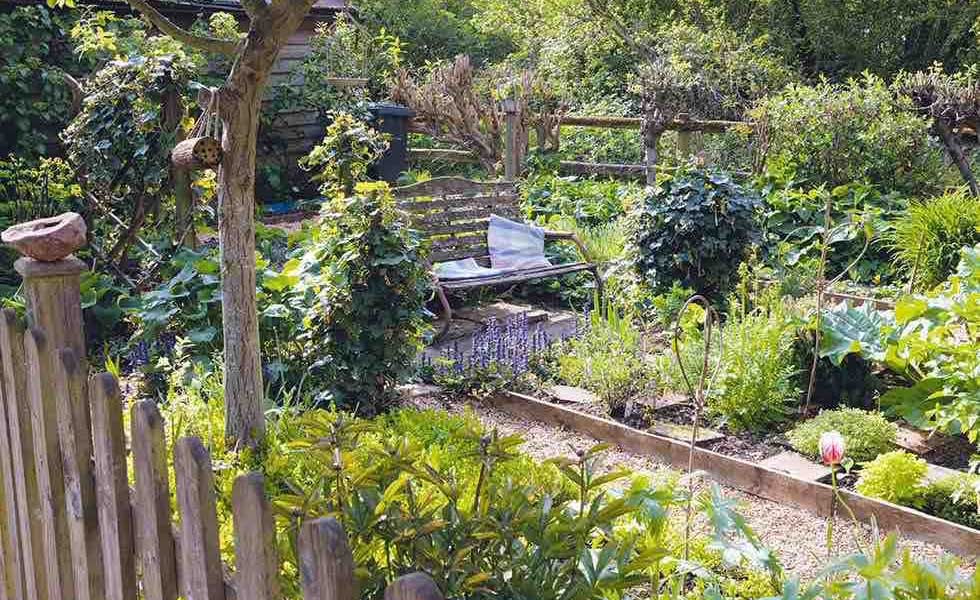
A garden bench is positioned where the gardener can rest a moment to admire the growing produce
‘Part of this garden is set out in a chequerboard design using old square bricks that were made here hundreds of years ago,’ says Barbara. ‘These are filled with herbs such as parsley, sage, rosemary and thyme, chives, fennel, lovage, chervil, mint and curry plants. I put mint, parsley and tulips in pots, as it’s easier to look after them, and the tomatoes in a small greenhouse.’
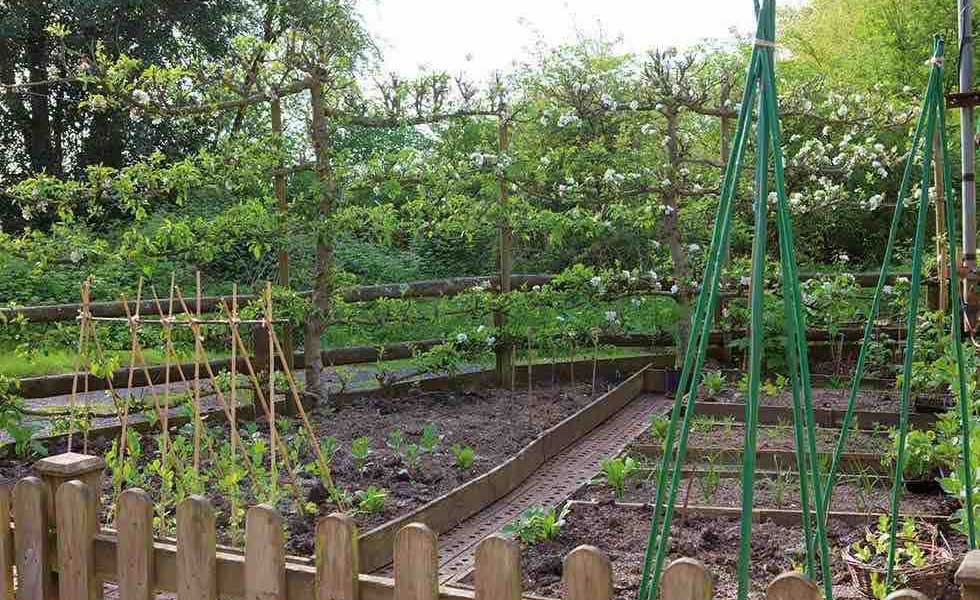
5. Bountiful artist's garden
In late summer, artist Lizzie Smith’s garden is at its best, with a cornucopia of vegetables in raised beds ready for harvest, billowing flowers to cut and the herbaceous beds filled out with golden Rudbeckia fulgida var. sullivantii ‘Goldsturm’, Nepeta ‘Six Hills Giant’ and Cynara cardunculus, or cardoons.
‘Our wish was to develop a productive, beautiful and creative garden for our family, friends and wildlife to enjoy being in and eating from. We have six children between us, so the garden is a great source of fresh vegetables and flowers, with lovely places to be in,’ says Lizzie.
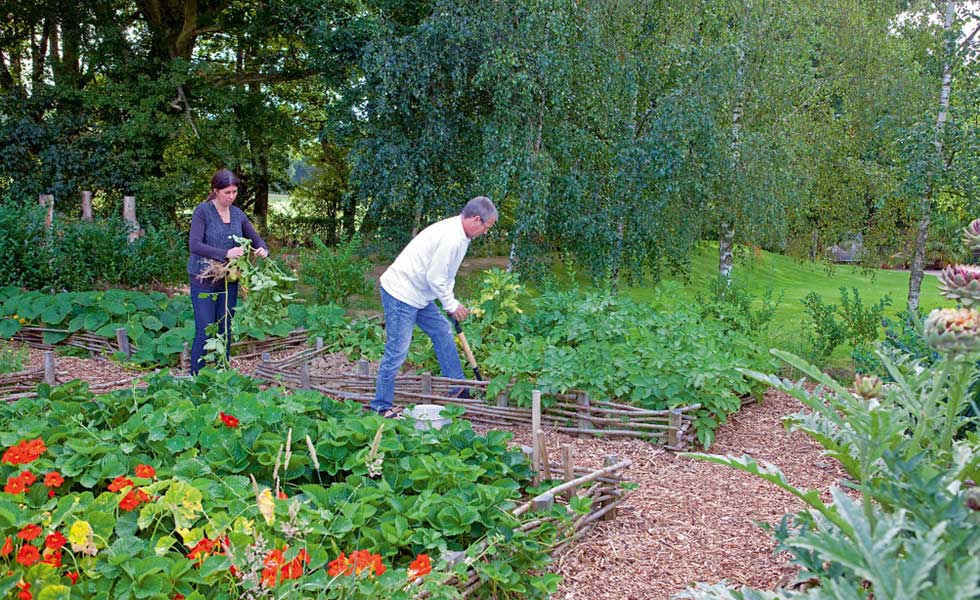
Created by artists, this kitchen garden reaches its zenith in late summer
The variety of produce is impressive, from herbs such as mint, rosemary, thyme and parsley at the front door, to tactile Cavolo Nero mixed with ornamental Cerinthe major ‘Purpurascens’ kept in check in the woven-edged beds, or ripening Victoria plums heavy on the bough. There is something edible in nearly every corner of the garden.
The garden has two main areas for vegetables, with large rectangular beds, along with the more tender offerings of chillies and aubergines in the polytunnel. ‘Tomatoes are our favourite vegetable and we grow ‘Black Krim’, ‘Marmande’, ‘San Marzano’ and ‘Costoluto Fiorentino’.’
6. A kitchen garden with contemporary touches

Cloches are used to protect the tender plants in this kitchen garden plot
The kitchen aspect of this garden isn’t the most obvious part. In fact it is used to punctuate the relaxed and colourful traditional planting scheme. Neat rows of salad and root vegetables sit between repeated box-balls and have all been hand grown by home owner Heather Scott from seed.

Heather tends to the plants in her greenhouse
The tiny greenhouse is home to Heather’s young potted plants and vegetables, before they can graduate into the main garden, to complement the garden borders and beds.
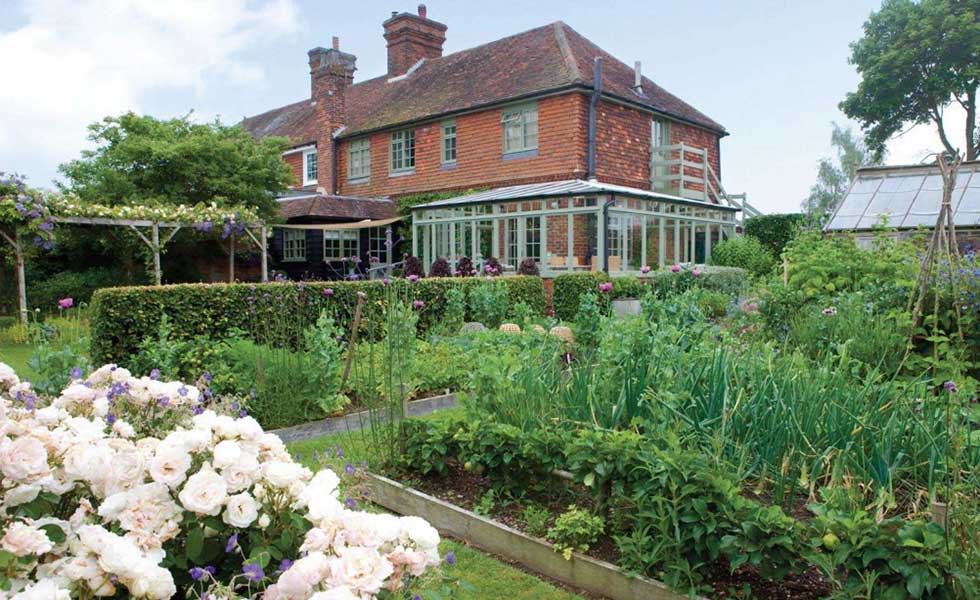
The Victorian house is framed by its beautiful gardens
7. Family garden in the Essex countryside
Having created a beautiful garden for her family, Victoria Inglis turned her attention to creating a small potager outside their potting shed, which is enclosed in woven hazel fences. ‘My husband and three children are quite “foodie”, so we enjoy cooking at home with our own produce. Raised beds made from wooden planks are filled with salad leaves, rhubarb, beans and root vegetables,’ says Victoria. Choose the very best garden shed with the help of our buyer's guide.
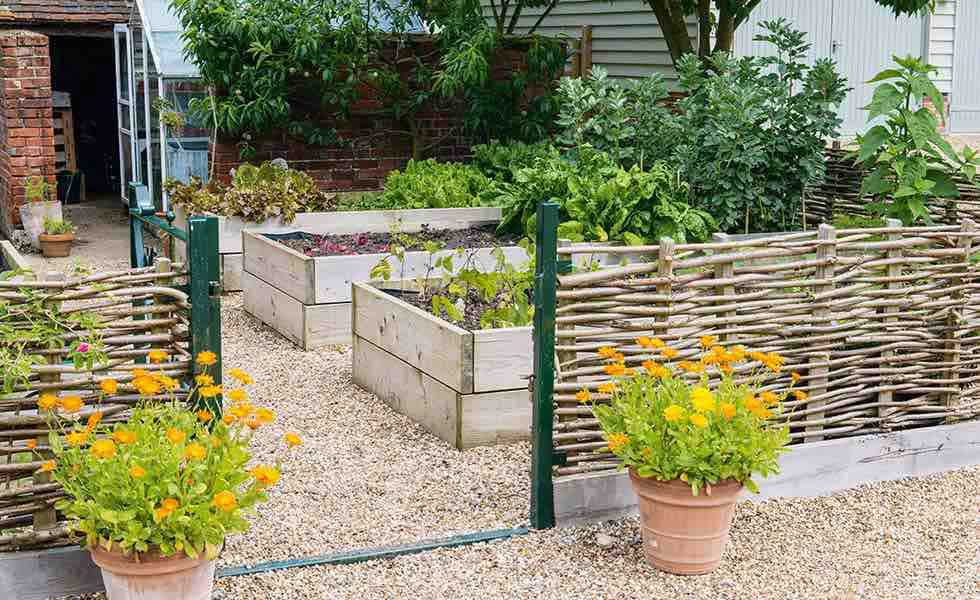
To finish off the kitchen garden, Victoria extended the small eating area on the south-easterly corner of the potting shed, and built a pergola, creating the perfect outdoor dining area to complement the productive kitchen garden.
Get more gardening advice from Period Living Magazine

Period Living is the UK's best-selling period homes magazine. Get inspiration, ideas and advice straight to your door every month with a subscription.
It's totally time to grow your own vegetable garden!
- Camille Dubuis-WelchFormer Deputy Editor